#eastern diamondback rattlesnakes
Text
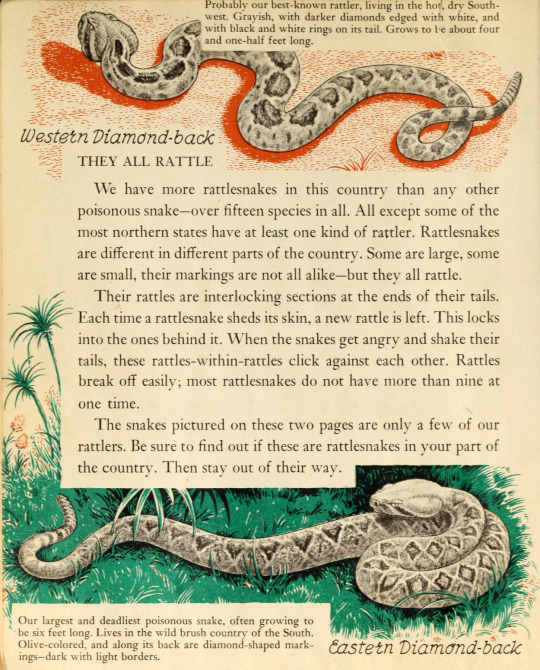
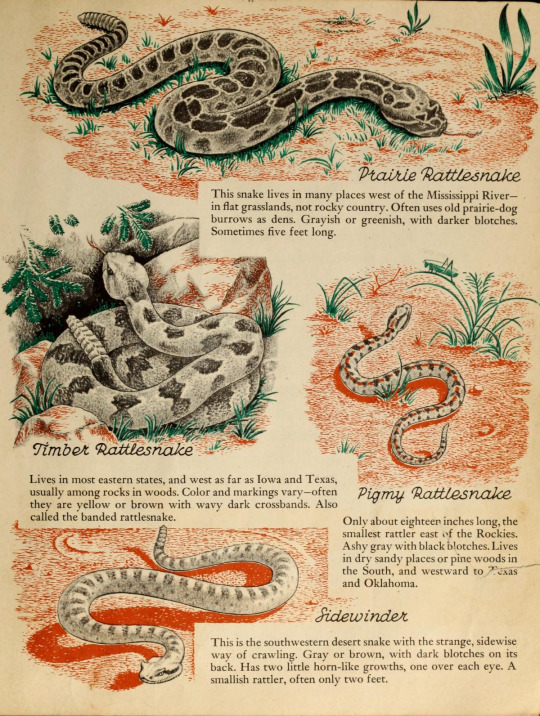
The First Book of Snakes. Written by John Hoke, illustrated by Paul Wenck. 1952.
#reptiles#snakes#rattlesnakes#western diamondback rattlesnakes#eastern diamondback rattlesnakes#prairie rattlesnakes#timber rattlesnakes#pygmy rattlesnakes#sidewinder rattlesnakes#Paul Wenck
127 notes
·
View notes
Text
Animal of the Day!
Eastern Diamondback Rattlesnake (Crotalus adamanteus)
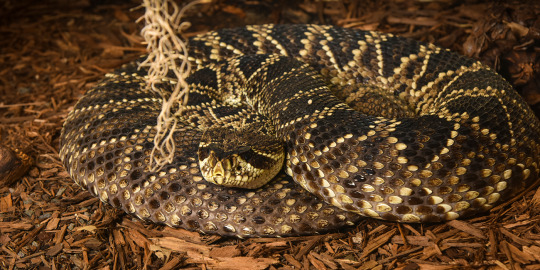
(Photo from Smithsonian’s National Zoo)
Conservation Status- Least Concern
Habitat- Eastern United States
Size (Weight/Length)- 6 kg; 1.5 m
Diet- Small mammals; Birds; Insects
Cool Facts- Being the largest and most venomous rattlesnake in North America, more people die from this snake than any other in the continent. Generally a slow moving hunter, the eastern diamondback rattlesnake basks on open rocks to warm up. After finding a bush or some leaflitter, the rattlesnake will ambush prey and bite it. The snake then follows the scent of the dying prey and swallow it whole after the animal dies. Being an excellent swimmer, eastern diamondback rattlesnakes can swim miles from land and towards oceanic islands in the Gulf of Mexico. Despite being highly venomous, rattlesnakes are often more afraid of you than you are of it. The snake uses its rattle to tell you to back off and it will only strike as a last resort. Best to watch your step and leave these guys alone.
Rating- 11/10 (You hear a rattle, you walk in the opposite direction.)
Animtober- Uh-Oh (Most dangerous snake in North America.)
#Animal of the day#Animals#Snakes#Rattlesnake#Pit viper#Saturday#October 29#Eastern diamondback rattlesnake#biology#science#conservation#the more you know#Animtober#Inktober#Uh-oh
161 notes
·
View notes
Text
BTW if you haven't already please take a minute to look up what venomous snakes are local to you and familiarize yourself with them
#i joined a local snake ID group recently#before that i knew roughly how to spot a pit viper and hownto tell a coral from a scarlet snake#but i didnt really know how to identify specific species other than copperheads#and now im very confident in my ability to tell water snakes from cottonmouths etc#and it gives really nice peace of mind#like. ive seen so many people here in the us south that will freak out of Any snake#my mom once was yelling and crying trying to get help over a kingsnake on the sidewalk cuz she didnt know if it could kill the dogs#and people will kill snakes if they dont know [and often will anyway but knowing helps foster appreciation]#and now i can see a snake and say thats a coachwhip. isnt it pretty. and will gently grab the back end to look at it for just a second more#before letting it go hide#idk. i saw a rattlesnake in the woods today#and its the first time seeing one in the wild like that. and yea it was scary tbh#and i got a pic but booked it out once it noticed me and reacted#but i wish i had stopped and watched it longer cuz it was super pretty#and i know it wouldnt have bothered me at all#im just glad that we've seen two big full sized diamondbacks here in the past few months. and i know theyre two individuals#because eastern diamondbacks are declining and its good to know theres a population here#idk. im getting sentimental over snakes i just love them#but my main point is its so easy to indentify snakes at least where im at#and learning to id them comes with learning to respect them
26 notes
·
View notes
Text



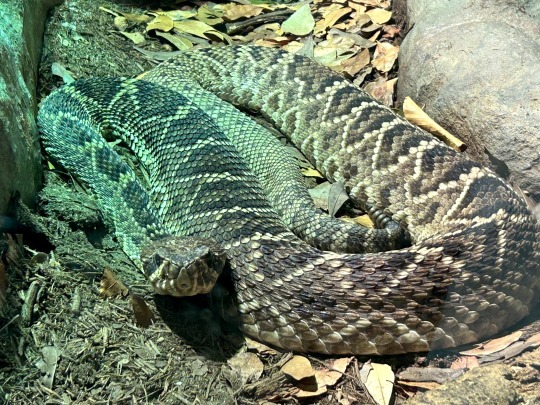
I really liked this exhibit for the eastern diamondback rattlesnake! It was quite large and was divided to have a forest-y soil / leaf litter / wetland section and a sandy section. I love when zoos (and hobbyists!) provide their animals with lots of choices to make with regards to their environment.
Greensboro Science Center
43 notes
·
View notes
Video
Eastern Diamondback by Lindell Dillon
Via Flickr:
Rare chance for an "in your face" photo of a venomous snake at the Oklahoma Trails exhibit in the OKC Zoo. Our beautiful world, being passed on.
#rattlesnake#herps#snakes#reptiles#okc zoo#oklahoma#wild oklahoma#eastern diamondback#flickr#lindell dillon#photographer#nature
19 notes
·
View notes
Text


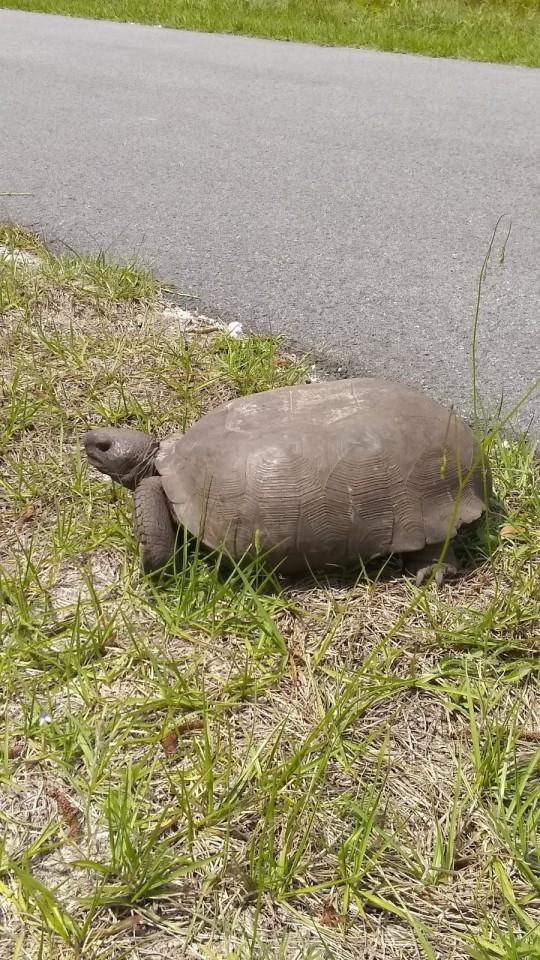

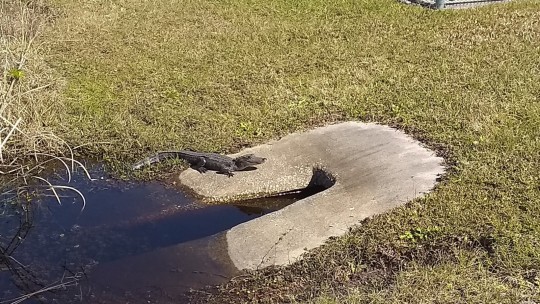


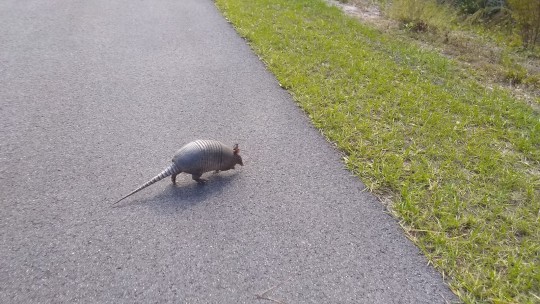

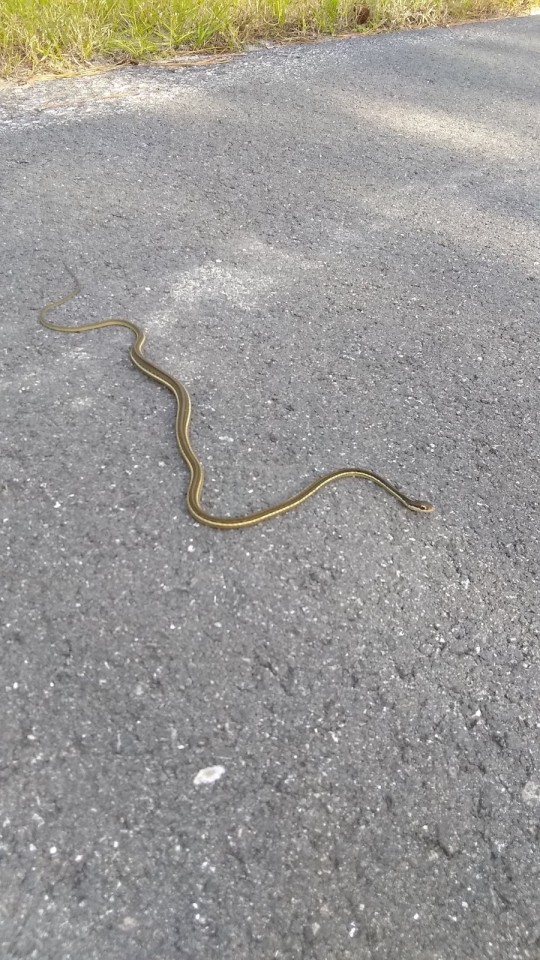
Critters of the East Coast Greenway aka The East Central Rail Trail from Titusville, Florida to Daytona Beach, or Tampa/St Pete.
Eastern Diamondback
Pygmy Rattlesnake
Cottonmouth
Corn Snake?
Armadillo
Gopher Tortoise
Eastern Box Turtle
Alligator
#snakes#eastern diamondback#cottonmouth#pygmy rattlesnake#gopher tortoise#titusville#spacecoast#florida#brevardcounty#centralflorida#east coast greenway#east central regional rail trail
5 notes
·
View notes
Text
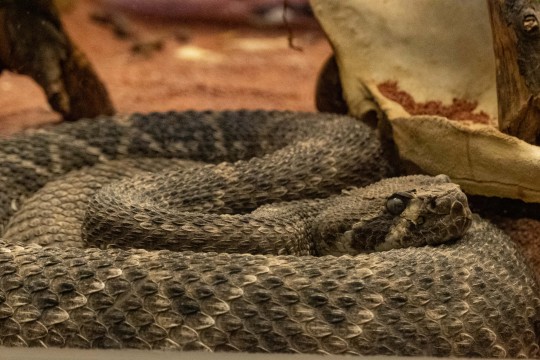
Crotale diamantin - Il mord sa proie, la relâche et la suit à la trace par l'odorat jusqu'à ce qu'elle succombe à son venin. Il mange généralement des petits mammifères (principalement des lapins et des rats). Il peut également manger des oiseaux ou des grands insectes. Les jeunes s'attaquent plutôt aux souris voire aux lézard.
Lieu : Zoo d'Anvers
#animaux#animals#animaux sauvages#wild animals#photo#photo animalière#zoo#animals photography#reptile#serpent#snake#crotale#crotale diamantin#diamondback rattlesnake#rattlesnake#eastern diamondback rattlesnake
2 notes
·
View notes
Text
The Remarkable Healing Power of Snake Venom
The Remarkable Healing Power of Venom discusses several ways that snake venom can be used for healing in conventional medicine. It relates how snakes, though scary to many people, can have some amazing healing properties in their venom.
Snakes and snake venom are often associated with danger and fear since everyone knows that snake venom has the power to kill. But what many people don’t realize is that it also holds incredible potential for saving lives. Behind the venomous fangs of snakes lies a complex chemical cocktail that researchers have been harnessing to develop life-saving medicines and treatments. These are just some…
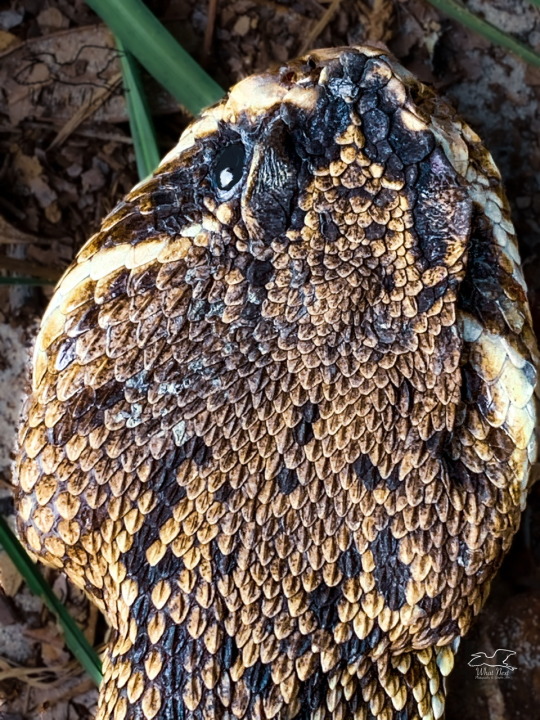
View On WordPress
#Eastern diamondback rattle snake#Florida snakes#Florida venomous snakes#medicinal uses for natural substances#medicinal uses for snake venom#medicine#nature#nature and medicine#nature photographs#nature photography#photography#rattlesnake#snake photographs#snake photography#snake venom#snake venom and medicine#snakes#venom and medcine#venomous snakes#veterinary medicine
1 note
·
View note
Text

Snakes: the Facts and the Folklore. Written/illustrated by Hilda Simon. 1973.
75 notes
·
View notes
Photo
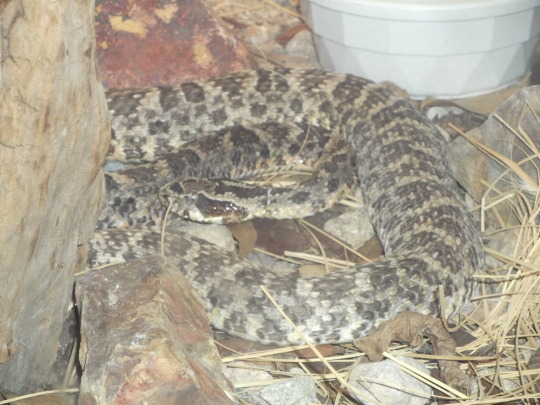
eastern diamondback rattlesnake
0 notes
Text
When will people stop posting snake posts that they stole and change the location. I hate you
#theres this one about the ornate blacktail rattlesnake going around#the post is like wow this is different than other diamondbacks ive seen#problem this stolen post was set to eastern iowa#and i know diamondbacks aren't native there#so i went huh#then they show the pretty rattlesnake#which the pictures and even wording were stolen from a post in 2019#stop this really dumb fearmongering of snakes please#people like me who know what snakes are native to certain areas will put you on blast
0 notes
Text




i'm currently taking pet portrait commissions to try and raise money to help pay for vet bills for three of our dogs that were bit by an eastern diamondback rattlesnake. two are young puppies who are currently hospitalized. i will only be doing headshots with a simple color background similar to as shown. dogs only. i'm taking 2 at a time. 2/2 slots open. $100 each. quickest way to reach me is through discord (user is boymayor). if you cannot/don't want to commission, please share around/rb. thank you <33
#art#digital art#art commission#pet portrait#commissions open#commission work#commission#whippet#pet commissions#artwork#sighthound
336 notes
·
View notes
Note
bit of a shitpost question- if you were the director of an occult government organization and you had the ability to give snakes human-level intelligence and shapeshifting abilities, what snake(s?) would you choose to make up the Wizard Tax Fraud Investigation Department?
This is SUCH a fun question, I love it!
Definitely king cobras are my pick for the WTFID. They're already smart and good problem-solvers, and the ease with which they can be trained would translate to a great attention to detail. I think they'd be able to handle this work with style and precision.
Because this is such a fun question and is giving me ideas for a short story with this premise, I had to think up a few more departments!
The Occult Artifacts Investigation Department would have to be staffed by smart snakes who love solving puzzles. Drymarchon snakes would be a perfect pick! I'd probably pick eastern indigos and blacktail cribos, because they're also friendly and fun to work with.
The Special Wizard Crimes department would be staffed with black mambas. Like king cobras, they're smart and detail-oriented, but black mambas are also super fast and don't mind thinking with their fangs when they have to.
Security would be rattlesnakes. They look tough and scary to people who don't know much about snakes, so they've got an intimidation factor, and I think they'd be crazy loyal to whoever gave them food. For variety, I'd probably have a mix of species; maybe Arizona black rattlers and eastern diamondbacks for intimidation, sidewinders for speed, Santa Catalina rattlers for stealth, and Mojave rattlers for power.
And the front-facing government members would obviously be hognose snakes. They'd have no issue with acting like they were more interested in their own problems than the organization's, and they'd be happy to play on their phones all day (of course I would give my snakes phones in this scenario) and just say "I don't know anything about any of this or any of the people involved" whenever anyone came around asking questions.
830 notes
·
View notes
Text
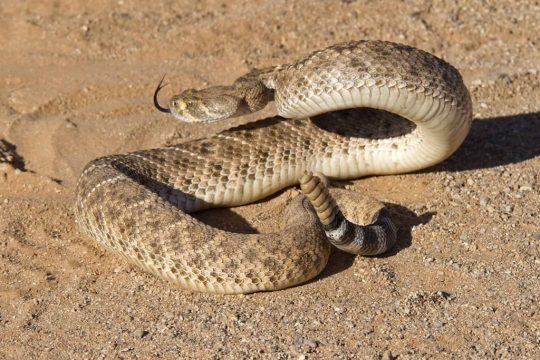

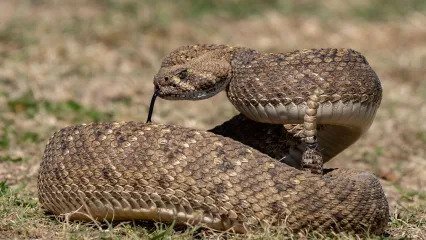

Wild Western Diamondback Rattlesnakes
Also known by the nicknames the Texas diamondback rattlesnake, the adobe snake, and the buzz tail, to name a few, the western diamondback rattlesnake (Crotalus atrox) is found throughout the southwestern United States and northern Mexico. This species is one of the iconic symbols of the region, and particularly of the deserts and scrublands in which it lives.
C. atrox has several features that distinguish it from its eastern relative. The western diamondback is slightly smaller, reaching a length of 1.5 m (4.9 ft) and a weight of 6.7 kg (14.7 lbs) at full maturity. They are also lighter in color, typically sporting tan, blueish gray, or pink scales with a darker diamond pattern along the body which gives the species its common name. Lastly, the face has white markings around the eyes and nostrils, and the tail below the rattle is white with black bands. Males and females appear similar; the most reliable way to tell the difference is by the tail. Male tails are thicker, longer, and taper gradually from the body, while female tails narrow abruptly at the base of the body.
The rattle itself is a unique feature of rattlesnakes. It is made of a series of hollow keratin chambers. When a rattlesnake is threatened, a set of muscles at the base of the tail constrict and cause the keratin chambers to vibrate against each other to produce a rattling sound. These muscles move incredibly fast, at about 50 times a second, and a rattle can be sustained for up to three hours-- not that most animals stick around that long. This rattle is present at birth as a tiny 'button', but juveniles are unable to rattle until their first molt, when a second segment is added. Rattlesnakes continue to add segments at each molt throughout their lives, but it's not uncommon for the top segments to become loose and fall off over time.
Mating for the western diamondback rattlesnake occurs in the fall and spring, from October to March. During the winter, individuals hibernate in abandoned burrows or under rocks, though some may emerge prematurely to seek out mates. Once they locate a female, males engage in an elaborate courtship ritual in which they chase the female, 'dance' in front of her, and fight other rival males. If the female is receptive, copulation can last for several hours. Following a successful mating encounter, females gestate for 167 days. Rattlesnakes are ovoviviparous, meaning that the female incubates her eggs inside her body and then gives birth to live young. After hatching, juveniles only stay with their mother a few hours before striking out on their own. Individuals reach maturity at three years old, and can live to be as old as 25.
Due to their venomous defence, C. atrox has few terrestrial predators. Their primary threats come from hawks, eagles, wild turkeys, and roadrunners, the latter of which have specifically evolved to hunt rattlesnakes. In contrast, the western diamondback rattlesnake has a broad appetite and hunts a variety of rodents, birds, and lizards. They are ambush predators, able to detect their prey through smell and heat. Rattlesnakes have a 'pit' on each side of their heads that contain a heat-sensing organ; this organ is so sensitive that an individual can detect prey only 1/10 of a degree warmer than its background.
Of the rattlesnake species, the western diamondback is considered one of the more aggressive, and is responsible for a majority of the snake bites in the United States. Its venom can be fatal to humans, partially due to the large amount of venom delivered in a single bite. However, C. atrox does not seek out human encounters, and only strikes when cornered. Antivenom for this species is available, and if administered soon after being bitten the recovery rate for victims is quite high.
Conservation status: The IUCN has designated the western diamondback rattlesnake as Least Concern. This species is heavily hunted throughout its range, both for its perceived threat to humans, and for its valuable meat and skin.
If you like what I do, consider leaving a tip or buying me a ko-fi!
Photos
Ned Harris and Wayne Klement
Wes Edens
Geoff Gallice
Derek Dykstra
#western diamondback rattlesnake#Squamata#Viperidae#rattlesnakes#vipers#Colubrid snakes#snakes#serpents#squamates#reptiles#deserts#desert reptiles#scrubland#scrubland reptiles#north america#southern north america#central america#animal facts#biology#zoology
136 notes
·
View notes
Text
Huge Rattlesnake Blocks Florida Road - AZ Animals
#florida#eastern diamondback#rattlesnake#titusville#spacecoast#brevardcounty#centralflorida#snakes#reptiles#largest venomous snake in north america
2 notes
·
View notes

